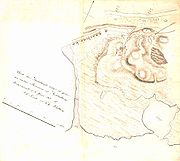
Paul Müller-Kaempff
Encyclopedia
Paul Müller-Kaempff was a German painter, illustrator and lithographer.

 He received his first training from 1883-86 at the Düsseldorf Academy of Fine Arts, then at the Academy of Karlsruhe
He received his first training from 1883-86 at the Düsseldorf Academy of Fine Arts, then at the Academy of Karlsruhe
under Gustav Schönleber (1851–1917) and finally at the Berlin Academy in the studio of Hans Gude
(1825–1903). Another of Gude's student during this period was Georg Müller vom Siel (1865–1939).
In 1905 he married his student, Else Schwager, and was appointed professor a year later. From 1908 he lived in Hamburg
, later becoming a member of the Hamburg Artists Association. In 1904 he and his wife were founder members of the Oldenburg Art Society.
Müller-Kaempff was a successful landscape artist. He produced watercolours, pastels and drawings as well as furniture designs and a multitude of postcards. He was also an accomplished lithographer and produced bird illustrations for the revised edition of Naumann's
"Naturgeschichte der Vögel Mitteleuropas". During his lifetime his works are acquired by museums in Rostock, Oldenburg, Kiel and Hamburg, and bought by numerous private collectors as far afield as Argentina
and China
. Prince Eitel Friedrich
, the second son of Emperor Wilhelm II, acquired several of Müller-Kaempff's pieces for the imperial court in 1908. Müller-Kaempff stayed in touch with his fomer fellow-student, Georg Müller vom Siel, and visited him at Dötlingen
in June 1908.
On a hike in 1889 with his friend, Oskar Frenzel (1855–1915), they discovered the secluded fishing village of Ahrenshoop
. Müller-Kaempff was so inspired by the isolated hamlet that he moved there, built himself a house in 1892, and started the painting school of St. Lucas in 1894. Fellow artists followed his lead, and soon the artists' colony was home to Anna Gerresheim (1852–1921), :de:Elisabeth von Eicken (1862–1940), Friedrich Wachenhusen (1859–1925), :de:Fritz Grebe (1850–1924), :de:Heinrich Schlotermann, :de:Theobald Schorn and Hugo Richter-Lefensdorf (1854–1904).


Karlsruhe
The City of Karlsruhe is a city in the southwest of Germany, in the state of Baden-Württemberg, located near the French-German border.Karlsruhe was founded in 1715 as Karlsruhe Palace, when Germany was a series of principalities and city states...
under Gustav Schönleber (1851–1917) and finally at the Berlin Academy in the studio of Hans Gude
Hans Gude
Hans Fredrik Gude was a Norwegian romanticist painter and is considered along with Johan Christian Dahl to be one of Norway's foremost landscape painters...
(1825–1903). Another of Gude's student during this period was Georg Müller vom Siel (1865–1939).
In 1905 he married his student, Else Schwager, and was appointed professor a year later. From 1908 he lived in Hamburg
Hamburg
-History:The first historic name for the city was, according to Claudius Ptolemy's reports, Treva.But the city takes its modern name, Hamburg, from the first permanent building on the site, a castle whose construction was ordered by the Emperor Charlemagne in AD 808...
, later becoming a member of the Hamburg Artists Association. In 1904 he and his wife were founder members of the Oldenburg Art Society.
Müller-Kaempff was a successful landscape artist. He produced watercolours, pastels and drawings as well as furniture designs and a multitude of postcards. He was also an accomplished lithographer and produced bird illustrations for the revised edition of Naumann's
Johann Friedrich Naumann
Johann Friedrich Naumann was a German scientist and editor.Naumann is regarded as the founder of scientific ornithology in Europe...
"Naturgeschichte der Vögel Mitteleuropas". During his lifetime his works are acquired by museums in Rostock, Oldenburg, Kiel and Hamburg, and bought by numerous private collectors as far afield as Argentina
Argentina
Argentina , officially the Argentine Republic , is the second largest country in South America by land area, after Brazil. It is constituted as a federation of 23 provinces and an autonomous city, Buenos Aires...
and China
China
Chinese civilization may refer to:* China for more general discussion of the country.* Chinese culture* Greater China, the transnational community of ethnic Chinese.* History of China* Sinosphere, the area historically affected by Chinese culture...
. Prince Eitel Friedrich
Prince Eitel Friedrich of Prussia
Prince Eitel Friedrich was the second son of Emperor Wilhelm II of Germany by his first wife, Augusta Viktoria of Schleswig-Holstein...
, the second son of Emperor Wilhelm II, acquired several of Müller-Kaempff's pieces for the imperial court in 1908. Müller-Kaempff stayed in touch with his fomer fellow-student, Georg Müller vom Siel, and visited him at Dötlingen
Dötlingen
Dötlingen is a municipality in the district of Oldenburg, in Lower Saxony, Germany. It is situated approx. 6 km northwest of Wildeshausen, and 25 km southeast of Oldenburg at the Hunte river....
in June 1908.
On a hike in 1889 with his friend, Oskar Frenzel (1855–1915), they discovered the secluded fishing village of Ahrenshoop
Ahrenshoop
Ahrenshoop is a municipality in the Vorpommern-Rügen district, in Mecklenburg-Vorpommern, Germany on the Fischland-Darß-Zingst peninsula of the Baltic Sea. It used to be a small fishing village, but is today known for its tourism and as a holiday resort....
. Müller-Kaempff was so inspired by the isolated hamlet that he moved there, built himself a house in 1892, and started the painting school of St. Lucas in 1894. Fellow artists followed his lead, and soon the artists' colony was home to Anna Gerresheim (1852–1921), :de:Elisabeth von Eicken (1862–1940), Friedrich Wachenhusen (1859–1925), :de:Fritz Grebe (1850–1924), :de:Heinrich Schlotermann, :de:Theobald Schorn and Hugo Richter-Lefensdorf (1854–1904).

